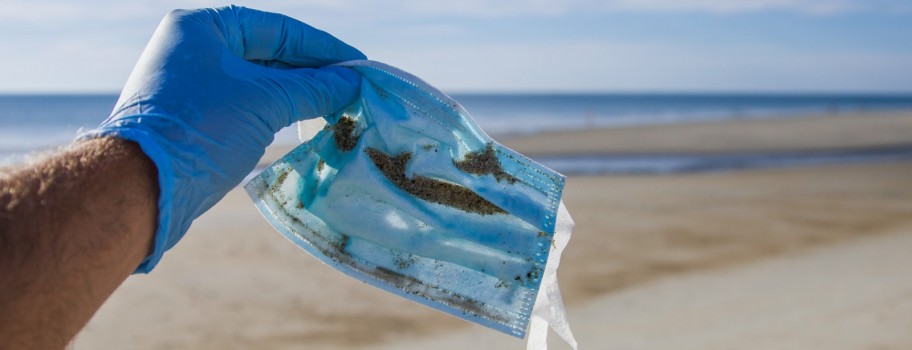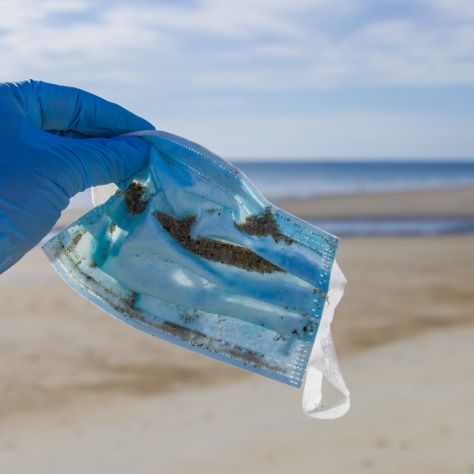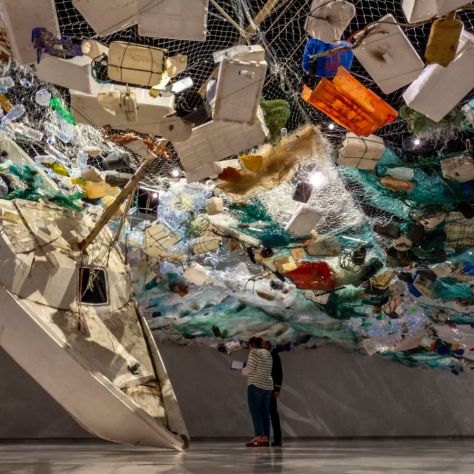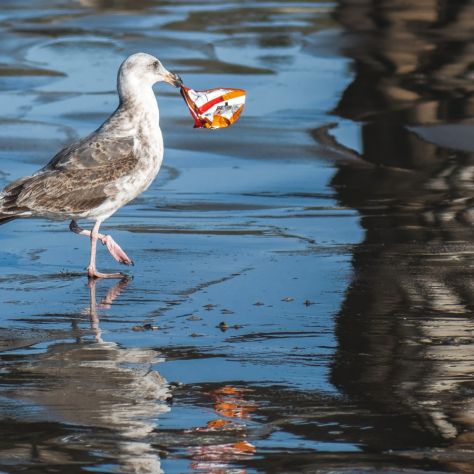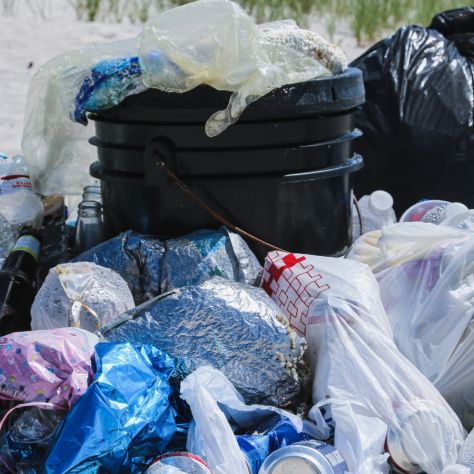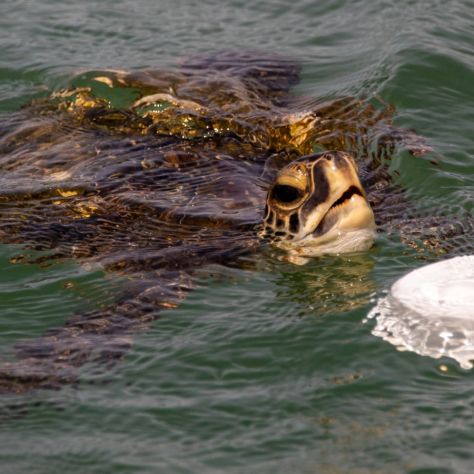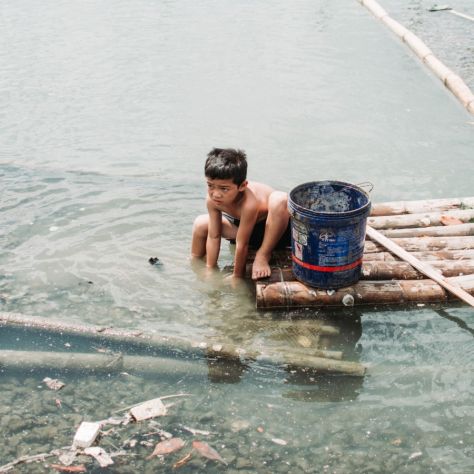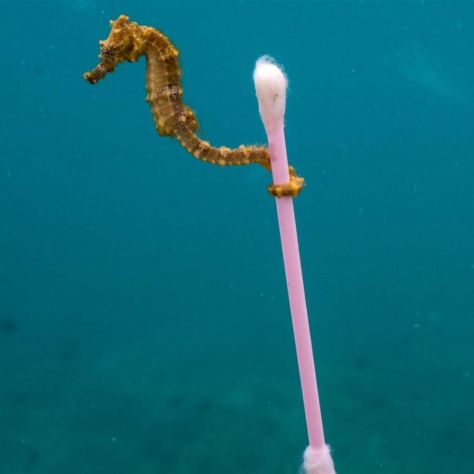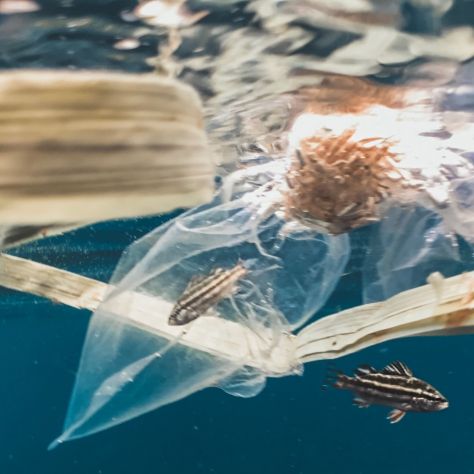
Updated: February 2022
The world’s production of plastic pollution since the 1950s is about 8.3 million tons, with projections expected to reach 640 million tons by 2035. With a huge reliance on plastic for our daily lives, the worldwide production per year is 300 million tons. 50% of the plastic output is expressly for single-use.
The management of this colossal amount of plastic is not sufficient. Every year, approximately 8 million tons of plastic finds its way into our oceans, and 90% of the ocean’s trash is from plastic. When you know the facts, it’s hard to ignore the irreparable damage to our planet, oceans, and wildlife.
We’ll walk you through the statistics with the hope of raising your awareness. Perhaps the facts will influence some of your daily decisions concerning the use of plastic bags and individual-use plastics. We’ve even got some fun and straightforward ways you can make a difference.
Article Contents
- Facts About Plastic Pollution: How Much Plastic is the World?
- Amount of Plastic in the Ocean and Sea: How Much Plastic is in the Ocean?
- Plastic Bag Facts: How Many Plastic Bags are in the Ocean?
- Harmful Effects of Plastic Pollution: What Exactly Are the Threats to the Ocean, Sea Life, and Humankind?
- What Can YOU Do? (to Turn the Tide)
The stats are staggering, and it’s only getting worse. The world is producing plastic pollution in alarming amounts without any satisfactory solutions in sight. Let’s do a deep dive into the vast ocean of plastic pollution statistics and how its tragic impact is drowning us all.

Photo Credit: Seahorse from Unsplash
Plastic Pollution Statistics (Top Picks)
- 300 million tons of plastic is the amount produced annually, but over 90% of it isn’t recycled
- the accelerated growth of plastic production is exponential, with more output in the last 10 years than in the previous century
- 1950 - 2018: world plastic production grew from 1.7 million tons per year in 1950 to an estimated 303.1 million tons by 2010 and nearly 396 million tons by 2018
- 2019 - 2035: world plastic production will grow to over 640 million tons by 2035
- The base for making plastic is petroleum, and at the current rate, to manufacture plastic, we use 8% of the world’s oil production
- approximately 8 million tons of plastic pollution enters our oceans every year (80% from the land), with an estimated 150 million metric tons already in our oceans and seas
- 70% sinks to the seafloor and infiltrates deep-sea sediments
- 15% floats wreaking all sorts of havoc for marine life
- 15% washes up onshore, destroying our beaches and coastlines
- 8 million pieces of plastic, every day, are dumped into the ocean
- 50% of plastic pollution is from single-use with only a few moments of “working life”
- 1% of plastic bags of the one trillion used worldwide are recycled
- The average use-time of plastic bags is 12 minutes, yet, tragically, it takes a plastic bag 500+ years to photodegrade (a process that creates microplastics that pollute the world and oceans even more).
- 5.25 trillion macro and microplastic pieces currently are afloat in the ocean and harms over 700 species of wildlife, and 500 marine areas have been declared "dead zones"
- Nearly all (over 90%) of seabirds have plastics in their stomachs, and 1,000,000 die every year from plastic pollution
- 1 in 3 sea mammals such as whales and dolphins get entangled in marine litter, and plastic pollution causes the death of 100,000 marine animals every year
- 1 in 3 sea turtles have ingested plastic, and 100% of baby sea turtles have plastic in their stomachs
- 1 in 3 fish for human consumption contains plastic
- High-income countries like The United States and the United Kingdom produce the most plastic pollution per person
- Middle and lower-income countries contribute the most to plastic pollution because of mismanagement
- The sector responsible for generating the most plastic production is packaging, followed by textiles
Facts About Plastic Pollution
How much plastic is in the world?
Over 9 million tons of plastic pollution exists in the world today, yet less than 10% of it recycled. This waste disposal is not adequate, with 12% burned and the 78% balance dumped into landfills or the environment. 90% of the trash floating in our oceans is made of plastic, around 46,000 pieces per square mile.
Which countries produce the most waste?
Countries with higher-incomes such as The United States and the United Kingdom produce the most plastic waste per person. Because of mismanagement, middle and low-income countries contribute the most plastic pollution. If we could improve the waste disposal management in the countries that need it most, we would make significant strides towards slowing the damage inflicted on our planet by plastic pollution.

Photo Credit: MD Duran on Unsplash
Key Statistics:
- Yearly world production is 300 million tons with projections to double by 2035
- 50% is for single-use purposes – and used for no more than 15 minutes before being discarded - yet polluting our planet for the next 500 years!
- The acceleration rate is staggering, and we have produced more plastic in the last decade than the entire previous century!
- The countries that contribute the most to plastic pollution because of mismanagement: China (28%), Indonesia (10%), Philippines and Vietnam (6%), Thailand (3.2%), Egypt (3%), Nigeria (2.7%), and South Africa (2%)
What is Plastic Pollution?
Plastic objects and particles made from petroleum build up in the Earth's environment in ways that adversely affect wildlife, wildlife habitat, and humans and are considered plastic pollution.
Plastic pollution is either primary or secondary:
1) Primary plastics are visibly identifiable
2) Secondary plastics result from the degradation of the primary plastics
Whether Primary or Secondary, as described below, there are three main categories of plastic pollution: 1) macroplastics; 2) microplastics; 3) nanoplastics.
Macroplastics = more than 5 (five) millimeters long
Plastics that are visibly identifiable.
Examples:
- Articles of clothing made from synthetic materials like nylon, acrylic, and polyester (1 load of laundry produces 700,000 microfibers)
- Plastic jars and bottles (75% of all plastic containers are bottles and jars)
- Plastic toothbrushes (1 billion toothbrushes are used and discarded annually by Americans)
- Cigarette filters (plastic fibers make up 98% of cigarette filters)
- Plastic Packaging (which accounts for 40% of plastic production)
Microplastics = less than 5 (five) millimeters long
Microplastics are macroplastics that have broken down into smaller pieces (secondary)
Examples:
- Plastic bags do not biodegrade. They “photodegrade,” which means they become brittle, break, and create smaller plastic particles (secondary microplastics) that continue to pollute the environment and harm wildlife, including humans, for over 500 years
- Microbeads (tiny pieces of polyethylene plastic added to health and beauty products for exfoliation purposes)
- Microfibers (one load of laundry produces 700,000 microfibers, or as car tires wear down, little fibers break off on the road and wash down the drain pipes)
Nanoplastics = measured in one-thousandths of a millimeter (um’s) or one-millionth of millimeters (nm)
Nanoplastics are so small; they’re not visible. They’re currently the least known type of plastic pollution but possibly the most toxic of all.
Sources:
- https://www.greenpeace.org/usa/key-facts-about-plastic-pollution/
- https://www.sas.org.uk/our-work/plastic-pollution/plastic-pollution-facts-figures/
- https://www.britannica.com/science/plastic-pollution
- https://plasticoceans.org/the-facts/
- http://www.planetexperts.com/macro-meso-micro-but-what-about-nanoplastic/
- https://www.nanopartikel.info/en/faq/2592-what-is-nanoplastic-and-what-is-it-applied-for#:~:text=Nanoplastics%20are%20particles%20that%20comprise,100%20nm%20in%20size%2C%20respectively
- https://ourworldindata.org/plastic-pollution
Amount of Plastic in the Ocean and Sea
How Much Plastic is in the Ocean?

Photo Credit: Martijn-Baudoin on Unsplash
A staggering 5.25 trillion tons of plastic is in our oceans. On top of that, 8.3 million tons of macroplastics (visually identifiable pieces) and microplastics (less than 5mm) enter our marine environments every year with estimates to double by 2025. The percentage of plastic that sinks to the bottom and pollutes our seabeds is 70%, the percentage of plastic that floats is 15%, and the portion of plastic that washes up on our shores and beaches is 15%.
Key Statistics:
- Every year, plastics weighing 8 million metric tons are dumped into the ocean with the 5.25 trillion macro, and microplastic pieces currently circulate our marine environments.
- Every day, an additional 8 million pieces of plastic pollution enter the ocean
- 80% of plastic pollution that enters the sea comes from the land. Discarded garbage and plastic on land flows down sewers, rivers, streams, and other waterways to eventually end up in our oceans
- Estimates show that the annual amount of plastic that enters our oceans will double
- 70% of plastics sink to the bottom of the ocean, especially after they get coated in algae, which makes them heavier
- 15% of plastics float
- 15% washes up on shore
- 500 marine areas classified "dead zones"
Scientists, whose descriptive terminology is stereotypically precise and technical, are at a loss for words. They’re reduced to referring to these statistics simply as the “wow factor” of ocean pollution.
Now that the world faces this stark reality, one would think that plastics’ production would halt or significantly reduce. Sadly, the trend is exponentially moving in the other direction, with plastic production increasing twenty-fold in the last 50 years. The harm is incomprehensible, and there are now 500 marine areas that total the size of the United Kingdom classified as “dead zones.” In the next section, we’ll explore more about the harm caused by plastic pollution and offer some recommendations for choices we can make as individuals to help change the direction we’re headed.
Sources:
- https://oceanservice.noaa.gov/hazards/marinedebris/plastics-in-the-ocean.html
- https://oceanconservancy.org/trash-free-seas/plastics-in-the-ocean/
- https://www.iucn.org/resources/issues-briefs/marine-plasticshttps://medium.com/@toothcrush/the-10-most-insane-images-of-plastic-suffocating-our-oceans-ec0d84cec908
- https://plastic-pollution.org/
- https://www.iucn.org/resources/issues-briefs/marine-plastics
- https://www.nhm.ac.uk/discover/quick-questions/how-much-plastic-is-in-the-ocean.html
- https://www.condorferries.co.uk/plastic-in-the-ocean-statistics
- https://www.nationalgeographic.org/article/ocean-trash-525-trillion-pieces-and-counting-big-questions-remain/
- https://www.sas.org.uk/our-work/plastic-pollution/plastic-pollution-facts-figures/
- http://seastewards.org/projects/healthy-oceans-initiative/marine-debris-and-plastics/
- https://ourworldindata.org/plastic-pollution
- https://medium.com/@toothcrush/the-10-most-insane-images-of-plastic-suffocating-our-oceans-ec0d84cec908
- https://whyy.org/segments/plastic-in-the-deep-ocean/#:~:text=%E2%80%9CWhat%20we%20expect%20is%20happening,and%20it%20sinks%20to%20bottom.%E2%80%9D
Plastic Bag Facts
How Are Many Plastic Bags (single-use plastics) in the Ocean?
 Photo Credit: Brian Yurasits on Unsplash
Photo Credit: Brian Yurasits on Unsplash
The plastic bag facts, including how many plastic bags end up in the ocean and the percent of plastic bags that are recycled, are as mind-boggling as the stats we’ve just learned. To offer some context in terms of scale, the amount of plastic pollution that enters our oceans each year (8 million metric tons) is the equivalent of covering every foot of coastline around the world with 5 plastic grocery bags per foot. By 2025, you can double that number to 10 grocery bags per foot of coastline.
With one trillion plastic bags used worldwide each year, a mere 1% is recycled per Waste Management. Consider this - when you go to the grocery store and use a plastic bag to carry home your groceries, the average use time of that plastic bag is less than 15 minutes. However, the life-span of those plastic bags on this planet is 500+ years. Surely, we can do something about that going forward by taking into consideration the impact our choices have on our environment and its wildlife.
Key Statistics:
- 500 billion = the number of plastic bags used worldwide every year
- 100 billion = the yearly number of plastic bags used by Americans
- 1 million = the number of bags used every minute
- 12 minutes = the average working time of a plastic bag
- 500+ years = the number of years a plastic bag pollutes the earth and continues to pollute the planet even after it photodegrades (it doesn’t biodegrade)
- 1% = the percent of plastic bags recycled
- 15 bags per year = the number of plastic bags that are recycled by each household even though 1,500 plastic shopping bags brought home
- 100,000 = the number of marine animals that die each year because of plastic bags each (more devastating stats of the effects of plastic pollution on wildlife below)
Harmful Effects of Plastic Pollution
What Exactly Are the Threats to the Ocean, Sea Life, and Humankind?
Plastic pollution is a problem created by us. We use it with reckless abandon because it's convenient, it's versatile, it's lightweight, and it's cheap. We use plastics that are helpful for many reasons throughout our daily lives, yet we do not realize the horrific hazards we cause.

Photo Credit: Marvin Meyer on Unsplash
Key Statistics:
- Plastic contains toxins such as PCBs, PBA, and phthalates, are linked to cancer and the disturbance of hormone balance
- Nearly 700 species, which includes endangered ones, are affected by plastic pollution
- 267+ different marine species have been harmed by plastic pollution
- 1 in 3 marine mammals are trapped and entangled by marine debris
- 1 out of 3 leatherback sea turtles have plastic in their stomachs*
- 9+ out of 10 of seabirds have plastic in their stomachs*
- Even in the deepest part of our oceans, scientists have found that 70% of amphipods (deep-sea creatures that resemble shrimp) have plastic in their stomachs*
- Plastics (especially microplastics and nanoplastics) are prone to absorb other deadly chemicals and health-damaging substances like pesticides, which only exacerbates matters
- Research shows there is now 6x more plastic than phytoplankton per weight and 50x more plastic than zooplankton in the ocean. Phyto (plant) and zoo (animal) planktons are living organisms that drift near the sea’s surface and are essential to sea life and are the base of its food chain.
- Studies show that plastic pollution is more dangerous to baleen whales than oil spills
*when a living organism has plastic filling up its stomach, it can no longer absorb the nutrients it needs to survive
When plastic pollution infiltrates the food chain, it causes a dangerous chain-reaction of epic proportions for every living organism on the planet.
To illustrate how plastic pollution affects all creatures, great and small, let’s look at the world’s largest mammal’s food chain, the endangered blue whale. Blue whales feed on krill, a shrimp-like creature that lives near the surface of the ocean or zooplankton. Krill feed on phytoplankton and single-cell plants that rely on sunlight and carbon dioxide to survive.
The first issue within this food chain is the challenge phytoplankton and plant organisms face by competing with floating trash that blocks the sunlight they need to grow. This situation diminishes the food supply for zooplankton like krill - which means fewer krill can survive. What’s worse? As krill feed on their limited food supply, plastic infiltrates their systems from phytoplanktons with ingested plastics. Then, along comes the beautiful, blue whale who opens its mouth to dine on the mainstay of its diet, krill, only to get a mouthful of macroplastic debris floating near the surface of the ocean plus krill with microplastics in their stomachs. You can see, we all have a whale-size problem - from the very smallest to the very largest of creatures.
To bring this reality closer to home, let’s quickly describe one way plastic makes its way onto YOUR dinner plate. Microplastics and nanoplastics infiltrate our sea beds at the bottom of the sea. Sea creatures that feed on the sea beds ingest the microplastics and nanoplastics (which, because of their molecular structure, absorb other toxins in addition to plastic poisons). Fish swim along and feed on the seabed. Bigger fish feed on smaller fish contaminated with nanoplastics, microplastics, macroplastics, and other toxins. And so on and so on….until a fantastic fish dish that ends up on your plate, and subsequently, in your stomach, is not quite as nutritious and delicious as you initially thought. Compromised nutrition can wreak all sorts of havoc on the human body.
In this situation, the saying, “what goes around comes around,” is very apropos. The more we pollute, the more plastic toxins leach into the food chain, and the more chain-reaction-challenges every living organism on our planet collectively faces.

Sources:
- https://plasticoceans.org/the-facts/
- https://www.biologicaldiversity.org/programs/population_and_sustainability/sustainability/plastic_bag_facts.html
- https://whyy.org/segments/plastic-in-the-deep-ocean/#:~:text=%E2%80%9CWhat%20we%20expect%20is%20happening,and%20it%20sinks%20to%20bottom.%E2%80%9D
- https://www.fisheries.noaa.gov/species/blue-whale#:~:text=They%20feed%20almost%20exclusively%20on,oceans%20except%20the%20Arctic%20Ocean.
- https://therevelator.org/toxic-plastic-pollution-food-chain/#:~:text=All%20rights%20reserved.-,Something%20Fishy%3A%20Toxic%20Plastic%20Pollution%20Is%20Traveling%20Up%20the%20Food,and%20seals%20%E2%80%94%20and%20by%20humans.&text=All%20rights%20reserved.-,Chemicals%20collect%20in%20microplastics%2C%20which%20then%20get%20eaten%20by%20fish,and%20seals%20%E2%80%94%20and%20by%20humans.
- https://www.vox.com/2019/5/24/18635543/plastic-pollution-bags-whale-stomach-beached
What Can YOU Do? (to turn the tide)
When a problem like this is so enormous, it overwhelms us. We drown in our mindset that it’s too late and that nothing can be done. The best way out of that downward spiral is to take one tiny step forward, which can make all the difference.
But HOW you may ask? Here’s an easy and fun way to help. Download the CleanSwell mobile app and join a global community that’s already collected 210 million pounds of trash over the last 30 years. The way it works is when you pick up a piece of trash, CleanSwell will keep track of the impact, as you’ll quickly see in the video below. You can even share your excellent work with your friends and family -- and get them inspired to do something too!
Here’s another story to help inspire you. Check out this vessel designed to skim plastics off the surface of the water. Calypso* would be proud!
Conclusion
The facts about plastic pollution are unfathomable. 300 million tons of plastic pollution are produced annually, with projections to reach 640 million tons by 2035. 50% of it stems from single-use plastics such as plastic bottles and bags, which have a “use-life” of less than 15 minutes yet remain on our planet and continue to pollute for centuries. 1% of the one trillion plastic bags used worldwide each year are recycled, an amount barely worth mentioning.
Every year, 8 million tons of plastic pollution flow into the ocean on top of the 5.25 trillion tons of macro and microplastic pollution that’s already there. The harm to humankind, wildlife, and our environment is horrifying, with over 700 species affected, many endangered. The way we dispose of our trash needs to be addressed, most urgently, in middle and low-income countries where there are no adequate systems in place.
By now, we understand the dangerous direction we are headed if we continue on this path. Fortunately, we CAN do something, and in the future, we can make a difference. The first step is to raise awareness of the issue, which we hope this article has provided.
We also hope you’ll take steps to make a difference and share this article with your friends and family. We know if you do...lo and behold, little by little...we’ll turn the tide in a positive direction!
We end with a quote from a beloved hero who dedicated his life to understanding our vast oceans and sea life. We will always remember him and his wondrous vessel, Calypso:
“The impossible missions are the only ones which succeed.”
—Commandant Jacques-Yves Cousteau
Sources:
- http://seastewards.org/projects/healthy-oceans-initiative/marine-debris-and-plastics/
- http://www.planetexperts.com/macro-meso-micro-but-what-about-nanoplastic/
- https://medium.com/@toothcrush/the-10-most-insane-images-of-plastic-suffocating-our-oceans-ec0d84cec908
- https://oceanconservancy.org/trash-free-seas/plastics-in-the-ocean/
- https://oceanservice.noaa.gov/hazards/marinedebris/plastics-in-the-ocean.html
- https://ourworldindata.org/plastic-pollution
- https://plastic-pollution.org/
- https://plasticoceans.org/the-facts/
- https://therevelator.org/toxic-plastic-pollution-food-chain/#:~:text=All%20rights%20reserved.-,Something%20Fishy%3A%20Toxic%20Plastic%20Pollution%20Is%20Traveling%20Up%20the%20Food,and%20seals%20%E2%80%94%20and%20by%20humans.&text=All%20rights%20reserved.-,Chemicals%20collect%20in%20microplastics%2C%20which%20then%20get%20eaten%20by%20fish,and%20seals%20%E2%80%94%20and%20by%20humans.
- https://whyy.org/segments/plastic-in-the-deep-ocean/#:~:text=%E2%80%9CWhat%20we%20expect%20is%20happening,and%20it%20sinks%20to%20bottom.%E2%80%9D
- https://www.biologicaldiversity.org/programs/population_and_sustainability/sustainability/plastic_bag_facts.html
- https://www.britannica.com/science/plastic-pollution
- https://www.condorferries.co.uk/plastic-in-the-ocean-statistics
- https://www.fisheries.noaa.gov/species/blue-whale#:~:text=They%20feed%20almost%20exclusively%20on,oceans%20except%20the%20Arctic%20Ocean.
- https://www.greenpeace.org/usa/key-facts-about-plastic-pollution/
- https://www.iucn.org/resources/issues-briefs/marine-plastics
- https://www.iucn.org/resources/issues-briefs/marine-plasticshttps://medium.com/@toothcrush/the-10-most-insane-images-of-plastic-suffocating-our-oceans-ec0d84cec908
- https://www.nanopartikel.info/en/faq/2592-what-is-nanoplastic-and-what-is-it-applied-for#:~:text=Nanoplastics%20are%20particles%20that%20comprise,100%20nm%20in%20size%2C%20respectively.
- https://www.nationalgeographic.org/article/ocean-trash-525-trillion-pieces-and-counting-big-questions-remain/
- https://www.nhm.ac.uk/discover/quick-questions/how-much-plastic-is-in-the-ocean.html
- https://www.sas.org.uk/our-work/plastic-pollution/plastic-pollution-facts-figures/
- https://www.vox.com/2019/5/24/18635543/plastic-pollution-bags-whale-stomach-beached
Cover Photo Credit: Justin Hofman on Unsplash
View More Statistics ArticlesJoin the conversation
You Might Also Like


How Many People Travel a Year? 30+ Travel Statistics (2023)

What are the Most Popular Pets? Pet Ownership Statistics, & Industry Trends for 2023
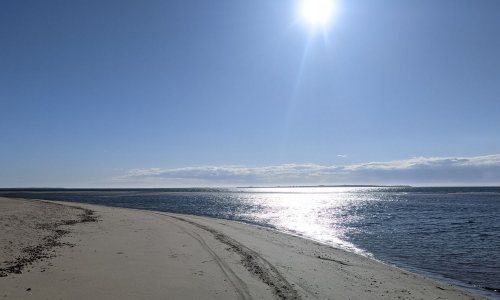
Jack Johnson’s “Fragments” Honors World Oceans Day

World Oceans Day
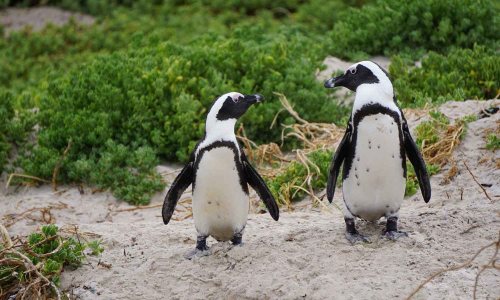
Gay Penguin Duo at Netherlands Zoo Nabs Egg
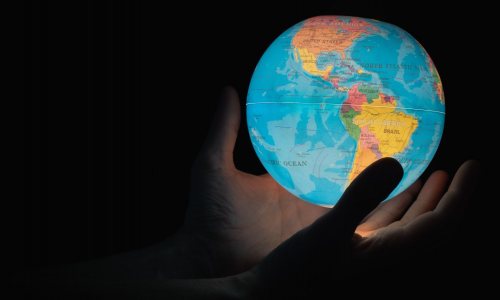
Travel and Tourism Statistics: What Are the Most Popular Countries to Visit? (2023)

Car Sale and Automobile Statistics (2023)

Why Are People Gay? Homosexuality Stats, Myths & Stereotypes (2023)
_500_300_84_s_c1.jpg)
Airplane Emissions and Air Travel Carbon Footprint Statistics

Drunk Driving Statistics: How Many Drunk Driving Deaths in 2023?

How Many Flights Per Day? Airline and Flight Statistics (2023)

What is Same Sex Marriage? 10+ Gay Marriage Statistics

When Was Homosexuality Decriminalized? LGBT Statistics & More

Online Travel Industry: Sales, Market Size, and Market Share (2023)


